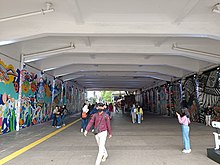| Transport in Jakarta | |
|---|---|
 People walking at Dukuh Atas TOD | |
| Overview | |
| Locale | Greater Jakarta |
| Transit type | Commuter rail, metro, light metro, people mover, bus rapid transit and bus, angkot, taxicab, motorcycle taxi, bajaj, private automobile, bicycle, pedestrian |
As a metropolitan area of about 30 million people, Jakarta has a variety of transport systems.[1] Jakarta was awarded 2021 global Sustainable Transport Award (STA) for integrated public transportation system.[2]
The city prioritized development of road networks, which were mostly designed to accommodate private vehicles.[3] A notable feature of Jakarta's present road system is the toll road network. Composed of an inner and outer ring road and five toll roads radiating outwards, the network provides inner as well as outer city connections. An 'odd-even' policy limits road use to cars with either odd or even-numbered registration plates on a particular day as a transitional measure to alleviate traffic congestion until the future introduction of electronic road pricing.
There are many bus terminals in the city, from where buses operate on numerous routes to connect neighborhoods within the city limit, to other areas of Greater Jakarta and to cities across the island of Java. The biggest of the bus terminal is Pulo Gebang Bus Terminal, which is arguably the largest of its kind in Southeast Asia.[4] Main terminus for long distance train services are Gambir and Pasar Senen. Whoosh High-speed railways is connecting Jakarta to Bandung and another one is at the planning stage from Jakarta to Surabaya.

As of September 2023, Jakarta's public transport service coverage has reached 86 percent, which is targeted to Increase to 95 percent. Rapid transit in Greater Jakarta consists of TransJakarta bus rapid transit, Jakarta LRT, Jakarta MRT, KRL Commuterline, Jabodebek LRT, and Soekarno-Hatta Airport Rail Link. The city administration is building transit oriented development like Dukuh Atas TOD and CSW-ASEAN TOD in several area across Jakarta to facilitate commuters to transfer between different mode of public transportation.
Privately owned bus systems like Kopaja, MetroMini, Mayasari Bakti and PPD also provide important services for Jakarta commuters with numerous routes throughout the city, many routes are/will replaced/replaced by Minitrans and Metrotrans buses.[5] Pedicabs are banned from the city for causing traffic congestion. Bajaj auto rickshaw provide local transportation in the back streets of some parts of the city. Angkot microbuses also play a major role in road transport of Jakarta. Taxicabs and ojeks (motorcycle taxis) are available in the city. As of January 2023, about 2.6 million people use public transportation daily in Jakarta.[6]
The city administration has undertaken a project to build about 500 kilometers of bicycle lanes. As of June 2021, Jakarta already has 63 kilometers of bicycle lanes, and another 101 kilometers will be added by the end of the year 2021.[7][8]
Soekarno–Hatta International Airport (CGK) is the main airport serving the Greater Jakarta area, while Halim Perdanakusuma Airport (HLP) accommodates private and low-cost domestic flights. Other airports in the Jakarta metropolitan area include Pondok Cabe Airport and an airfield on Pulau Panjang, part of the Thousand Island archipelago.
Indonesia's busiest and Jakarta's main seaport Tanjung Priok serves many ferry connections to different parts of Indonesia. The old port Sunda Kelapa only accommodate pinisi, a traditional two-masted wooden sailing ship serving inter-island freight service in the archipelago. Muara Angke is used as a public port to Thousand Islands (Indonesia), while Marina Ancol is used as a tourist port.[9]
For payment method in public transportation (for KAI Commuter line, TransJakarta, LRT Jakarta, LRT Jabodebek, MRT Jakarta) already using cashless. Travelers can use Electronic money banking cards. The electronic money cards include those issued, namely:
- BRIZZI (issued by Bank BRI)
- TapCash (issued by Bank BNI)
- e-Money (issued by Bank Mandiri)
- Flazz (issued by Bank BCA)
- Jakcard (issued by Bank DKI)
The electronic banking cards is integrated cad can be accepted in KAI Commuter line, TransJakarta, LRT Jakarta, LRT Jabodebek, MRT Jakarta, eToll payment and parking payment. The electronic bank card can be bought in Bank Branch office or in e-commerce.
For the electronic banking card Top Up can be done at:
- Indomaret Outlet (convenient store).
- Alfamart Outlet (convenient store).
- Alfamidi Outlet (convenient store).
- Bright Store Outlet (convenient store).
- e-Money Card Vending Machine.
Jakarta is part of the Maritime Silk Road that runs from the Chinese coast via the Suez Canal to the Mediterranean and there to the Upper Adriatic region.[10][11][12]
- ^ Joe Cochrane (4 August 2013). "Hours to Go, Just to Get to Work: Indonesians Cope With Infuriating Traffic and Inefficient Public Transit". The New York Times. Retrieved 5 August 2013.
- ^ "Jakarta wins global 2021 Sustainable Transport Award for integrated public transportation". The Jakarta Post. Retrieved 31 October 2020.
- ^ "Transportation Issues and Future Condition in Tokyo, Jakarta, Manila and Hiroshima" (PDF). Retrieved 11 May 2010.
- ^ "Pulo Gebang, Terminal Terbesar se-ASEAN Diresmikan 28 Desember". Liputan6. Retrieved 12 June 2017.
- ^ Kurniawan, Ruly. "Ini Pengganti Metromini di Jakarta". detikoto (in Indonesian). Retrieved 13 October 2020.
- ^ "Heru Budi Asks Transjakarta to Add More Buses to Reduce Congestion". Tempo. Retrieved 1 February 2023.
- ^ "Get ready for a bike revolution". The Jakarta Post. Retrieved 5 June 2021.
- ^ "Anies Baswedan Suggests Incentives for Workers Riding Bike to Work". Tempo. Retrieved 5 June 2021.
- ^ "Pelabuhan Muara Angke Siap Digunakan". Retrieved 13 August 2020.
- ^ Shenntyara, Mirtha (22 September 2017). "Indonesia: Asia's maritime gateway to the west". Archived from the original on 17 April 2021. Retrieved 21 January 2021.
- ^ Hernig 2018, p. 112; Hartmann, Maennig & Wang 2017, p. 59
- ^ Yuniarni, Sarah. "Here's How Indonesia Can Benefit From China's Belt and Road Initiative". Jakarta Globe. Archived from the original on 28 October 2021. Retrieved 28 October 2021.